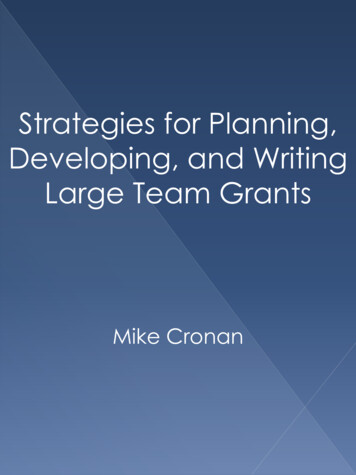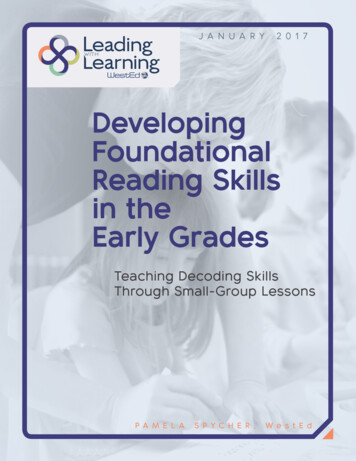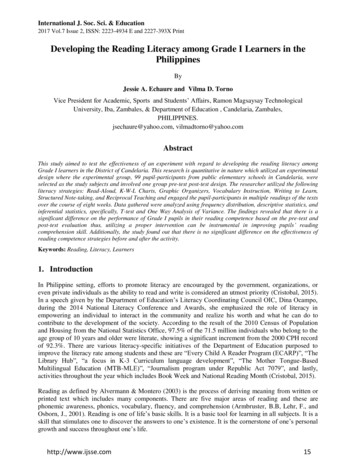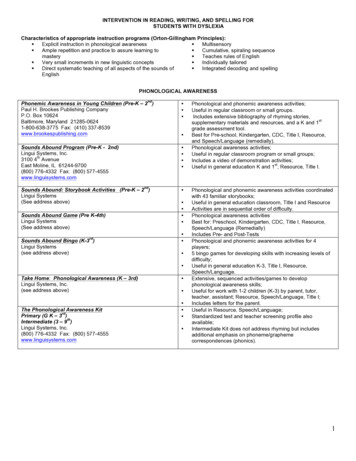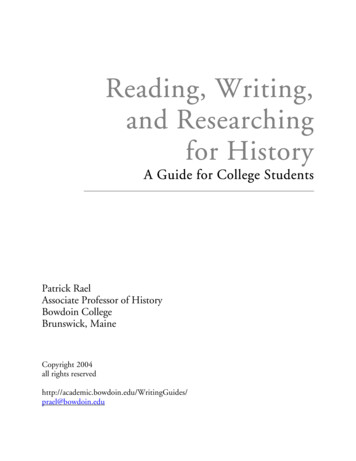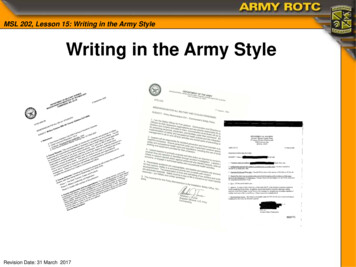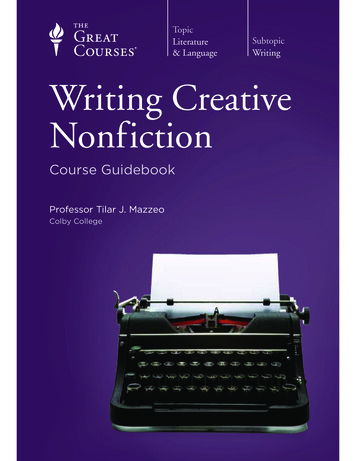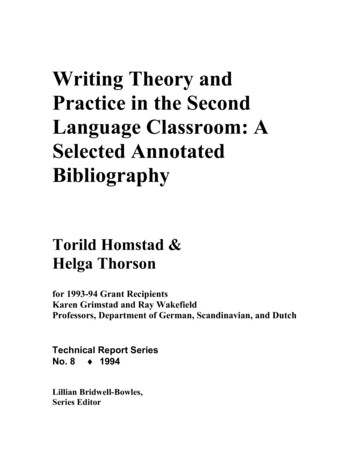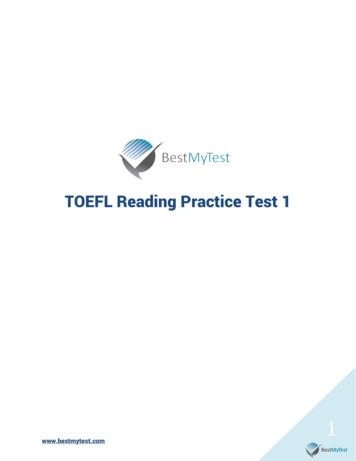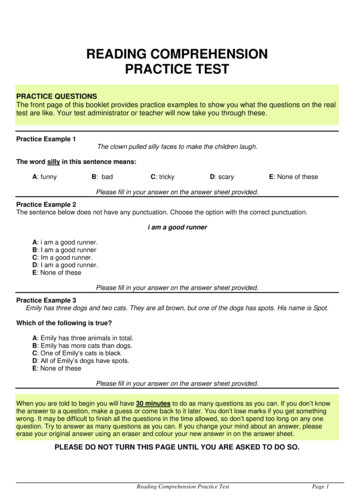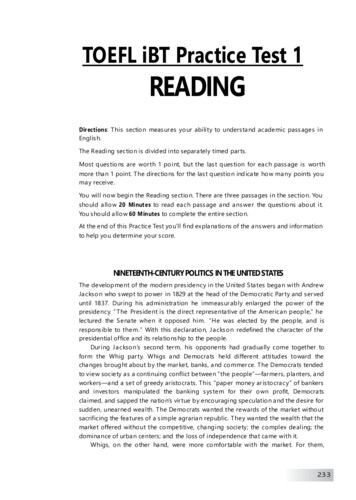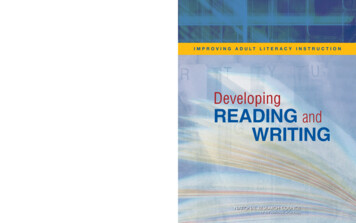
Transcription
I m p r o v i n g A d u l t Li t e r a c y I n s t r u c t i o nDrawing on the latest research evidence, this booklet, Improving Adult Literacy Instruction: DevelopingReading and Writing, gives an overview of how literacy develops and explains instructional practices thatcan help adults learn to read and write. Intended to be a useful resource for those who design or administer adult literacy courses or programs, this booklet may also be of interest to teachers and tutors.Also of Interest This booklet, Developing Reading and Writing, is drawn from the NationalResearch Council’s report Improving Adult Literacy Instruction: Options forPractice and Research. The report recommends a program of research andinnovation to gain a better understanding of adult literacy learners, improveinstruction, and create the supports adults need for learning and achievement. The report also identifies factors that affect literacy development inadolescence and adulthood and examines their implications for strengtheningliteracy instruction for this population. In addition, the report explores technologies that show promise for supporting adult literacy learners.The report is a valuable resource for curriculum developers, federal agencies,literacy program administrators, educators, and funding agencies.A companion to this booklet, Improving Adult Literacy Instruction: SupportingLearning and Motivation, explains principles that instructors can follow to support literacy learning and students’ motivation to persist in their studies. Thebooklet also explores promising technologies for adult literacy instruction.Copies of both booklets are available from the National Academies Press, 500 Fifth Street, N.W.,Washington, DC 20001; (800) 624-6242; http://www.nap.edu.DevelopingREADING andWRITING
CONTENTS3How Literacy Develops7Effective Reading Instruction13Effective Writing Instruction17Instruction for Struggling Readers and Writers18Instruction for English Language Learners21Motivation23Research on Adult Literacy InstructionABOUT THIS BOOKLETThis booklet was prepared by the Division of Behavioral and Social Sciences and Education (DBASSE) basedon the report Improving Adult Literacy Instruction: Options for Practice and Research (2012) which was authoredby the Committee on Learning Sciences: Foundations of and Applications to Adolescent and Adult Literacy. Thestudy was sponsored by the U.S. Department of Education. Any opinions, findings, conclusions, or recommendations expressed in this publication are those of the National Research Council and do not reflect those of theDepartment of Education.A PDF of this booklet is available free to download at http://www.nap.edu/catalog.php?record id 13242.Print copies are available from the National Academies Press at (800) 624-6242 or (202) 334-3313 (in theWashington, DC, metropolitan area) or via the NAP Website at www.nap.edu.Committee on Learning Sciences: Foundations and Applications to Adolescent and Adult Literacy:ALAN M. LESGOLD (Chair), School of Education, University of Pittsburgh; KAREN COOK, Department ofSociology, Stanford University; AYDIN Y. DURGUNOĞLU, Department of Psychology, University of Minnesota,Duluth; ARTHUR C. GRAESSER, Psychology Department, University of Memphis; STEVE GRAHAM, SpecialEducation and Literacy, Peabody College of Vanderbilt University; NOEL GREGG, Regents’ Center forLearning Disorders and Psychology Department, University of Georgia, Athens; JOYCE L. HARRIS, Collegeof Communication, University of Texas at Austin; GLYNDA A. HULL, Graduate School of Education, Universityof California, Berkeley; MAUREEN W. LOVETT, Hospital for Sick Children and University of Toronto; DARYL F.MELLARD, School of Education, University of Kansas; ELIZABETH B. MOJE, School of Educational Studies,University of Michigan; KENNETH PUGH, Haskins Laboratories, New Haven; CHRIS SCHATSCHNEIDER,Department of Psychology, Florida State University; MARK S. SEIDENBERG, Department of Psychology,University of Wisconsin–Madison; ELIZABETH A.L. STINE-MORROW, Department of Education andPsychology, University of Illinois; MELISSA WELCH-ROSS, Study DirectorABOUT THE NATIONAL RESEARCH COUNCIL AND DBASSEThe National Research Council is the principal operating agency of the National Academy of Sciences andthe National Academy of Engineering. The National Academy of Sciences, National Academy of Engineering,Institute of Medicine, and National Research Council make up the National Academies. They are private,nonprofit institutions that provide science, technology, and health policy advice under a congressional charter.For more information, visit http://national-academies.org.The Division of Behavioral and Social Sciences and Education (DBASSE)—one of five divisions within theNational Research Council—works to advance the frontiers of the behavioral and social sciences and education research and their applications to public policy. DBASSE gathers experts from many disciplines whovolunteer their services on study committees to provide independent, objective advice to federal agencies,Congress, foundations, and others through publicly issued reports. For more information on DBASSE’s work,visit http://sites.nationalacademies.org/DBASSE.July 2012
Improving Adult Literacy InstructionDevelopingReading and WritingMore than an estimated 90 million adults in the United States lack theliteracy skills needed for fully productive and secure lives. The effects ofthis shortfall are many: Adults with low literacy have lower rates of participation in the labor force and lower earnings when they do have jobs,for example. They are less able to understand and use health informa-tion. And they are less likely to read to their children, which may slow their children’sown literacy development.At the request of the U.S. Department of Education, the National Research Council convened a committee of experts from many disciplines to synthesize research on literacyand learning in order to improve literacy instruction for adults in the United States.The committee’s report, Improving Adult Literacy Instruction: Options for Practiceand Research, recommends a program of research and innovation to better understandadult literacy learners, improve instruction, and create the supports adults need forlearning and achievement.This booklet, which is based on the report, presents an overview of what is knownabout how literacy develops, the component skills of reading and writing, and thepractices that are effective for developing them. It also describes principles of readingand writing instruction that can guide those who design and administer programsor courses to improve adult literacy skills. Although this is not intended as a “how to”manual for instructors, teachers may also find the information in this booklet helpful asthey consider how to plan instruction.The principles described here apply to all adult literacy learners, including those learning English as a second language and those with learning disabilities. This booklet alsoincludes specific principles to guide instruction for those groups of learners.
2Developing Reading and WritingThe principles and practices offered here reflect the best available research on effectiveapproaches to literacy instruction, and they should be applied now in developing instruction for adults. However, it is important to know that these principles and practicesare derived mainly from research with younger students—from kindergarten throughhigh school (K-12)—because little research has been conducted on effective literacyinstruction specifically for adults. The principles and practices also reflect the growingliterature on adolescent learners, as well as general research on how people learn.The approaches presented here will need to be modified to account for adults’ uniqueneeds and learning goals. Precisely what needs to be taught and how it is taught willvary, depending on the individual’s existing literacy skills, learning goals, age, motivation, and cultural and linguistic background.As Improving Adult Literacy Instruction: Options for Practice and Research explainsin detail, far more research is needed to determine how best to adapt the guiding principles and practices to meet the needs of adult learners. That needed research is describedbriefly in this booklet’s conclusion. The people who develop, administer, and fund adultliteracy instruction and those who prepare instructors will have important roles to play inthese studies as they work to help all adults meet modern literacy demands.Who Are Adult Literacy Learners?The diverse groups of people who need stronger literacy skills in the United States include: recent immigrants who have little education in their native languages; middle-aged and older U.S.-born high school graduates who can no longer keep up with thereading, writing, and technology demands of their jobs; adolescents and adults who dropped out of school; adults who had disabilities that were not fully accommodated in school; highly educated immigrants who are literate in their native language but need to learn to readand write in English; and underprepared students in colleges.These groups receive literacy instruction in many settings, including schools, community organizations, community colleges, prisons, and workplaces.
How Literacy DevelopsAconceptual model to describe how literacy develops is shown in Figure 1.It shows several key factors that affect learners’ literacy development—the learning context, texts and tools, literacy activities, and the learner—and it also shows the aspects of each of these factors that are possible toinfluence through instruction. The following brief section discussesseveral of these factors, along with research-based guidance on how to influence themto support learning.Goals for learning andliteracyText featuresTools embedded intextInstructional practicesMotivating featuresCultural and languagenormsMotivating featuresTheLearningContextTheLearnerText andToolsDevelopmentof LiteratePracticeKnowledge/skills for comprehension,production, and use of textMotivationNeurocognitive differencesEducationLinguistic backgroundLiteracy learning goalsFIGURE 1: Model of the development of literate practiceSkill demandsLiteracyActivity andPurposeWhat goal does thisliteracy activity achievefor the student?
4Developing Reading and WritingLiteracy texts. Developing readers need to confront texts that are challenging, meaningful, and engaging. Texts should allow learners to practice component literacy skills(described below) and support them as they stretch beyond existing skills. Instructors should carefully select texts with the appropriate level of difficulty: texts thatboth draw on knowledge students have already mastered and also present challenges.Instructors also should provide prompts and other forms of support to learners as theywork their way through challenging texts.Effective instruction uses a variety of texts because when learners acquire knowledge andskills across multiple contexts, they are better able to retain what they learn and transferit to new tasks and situations. Unfortunately, there are few reading materials that are designed to foster the component skills of developing readers while offering interesting anduseful content to adolescents and adults. A priority for research is to develop and evaluatematerials and texts that can support this key element of effective instruction.Literacy tools. Being literate demands proficiency with current tools and practices thatrequire reading and writing—including digital and online media used to communicatewith others and to gather, evaluate, and synthesize information. It is important, therefore, to offer reading and writing instruction that incorporates the use of both print anddigital methods of communication. This type of instruction prepares learners to accomplish important reading and writing tasks that are indispensable in today’s world.Literacy activities and purposes. Novice learners require thousands of hours of practice to develop expertise in complex domains such as reading and writing. Even thosewho are not novices require substantial practice using reading and writing skills forparticular purposes. To motivate learners to persist for the long time it takes to developexpertise, it is important for instructors to understand the component literacy skills thatlearners need to meet today’s social, educational, workplace, and personal demands, andplan instruction with activities that develop those skills.This type of instruction, which helps learners develop component skills as they performpractical literacy tasks, also increases the likelihood that literacy skills will be usedoutside the classroom. Research on learning has shown that the likelihood of transferring a newly learned skill to a new task depends on the similarity between the new taskand the tasks used for learning. Therefore, literacy instruction is most likely to lead todurable, transferable learning if it incorporates real-world activities, tasks, and tools.In addition, activities that integrate reading and writing instruction contribute to thedevelopment of both skills. Reading and writing require some of the same knowledge
Developing Reading and Writingand cognitive and linguistic processes—such as knowledge of vocabulary, spelling patterns, text structures, and syntax—and so learning and insights in one area can lead tolearning and insights in the other. In fact, research has shown that reading improveswith frequent writing.Characteristics of the learner. Adult literacy learners vary in many ways—in theirliteracy development needs and goals, education levels, economic status, culture, linguistic background, and social, psychological, and neurobiological characteristics. To beeffective instruction should be adapted for different groups of learners.The varying ages of adult learners also has implicationsfor instruction. Although most adults who receive literacy instruction are in their 20s and 30s, along with anincreasing number of youth who have dropped out of highschool, a significant portion of learners—18 percent—areover 40. That percentage can be expected to increase during economic downturns and shifts that require adults tofurther develop their skills to meet the literacy demandsof available jobs. Understanding this older group of learners is important because adults as young as mid-30s mayexperience some age-related changes in brain processing.Though most of the processes involved in reading andwriting appear to be largely unchanged in later adulthood,older adults do experience declines in areas affected by visual perception and speedof processing—changes that might need consideration when planning instruction andpractice.Other age-related shifts may occur as well. Although word recognition appears to befundamentally unchanged throughout the adult lifespan, with age, readers tend to relymore on recognizing a whole word as a unit instead of decoding it using phonics skills.This characteristic is important because a facility with phonics is essential for readingnew words. Yet in both spoken and written communication, aging learners may increasingly rely on the context to recognize individual words. Memory declines can contribute to difficulties in connecting different parts of context needed for comprehension.Older adults might find it necessary to use such strategies as making notes and rereading parts of texts, for example. On the positive side, however, the knowledge that adultsaccumulate over their lifetimes can aid comprehension.5
6Developing Reading and WritingLiteracy in a Digital AgeIn today’s world, expectations for literacy includethe use of digital and online media to communicate and to produce, find, and evaluate information to meet educational and work demands.Strong reading and writing skills underpin valuedaspects of digital literacy in many key areas ofwork and daily life, such as: presenting ideas, including organizing a compelling argument, using multiple media, andintegrating media with text; using online resources to search for information, evaluate the quality of that information,and organize information from several sources;and using basic office software to generate textsand multimedia documents, including writingdocuments, taking notes, and preparing displays to support oral presentations.Researchers are only beginning to identify the literacy skills related to technology use andto study the kinds of instruction that can develop them for learners of all ages. Until more isknown about those skills, however, using technologies for literacy study can offer practicalbenefits to learners who will need to use digital tools in education settings and for their jobs.
Effective Reading InstructionMastery of reading requires developing its highly interrelated major component skills: decoding, vocabulary, fluency, and comprehension. Thesecomponents are discussed separately below, but they work together inthe process of reading. Effective reading instruction explicitly and systematically targets each component skill that needs to be developed andsupports the integration of all of them. Although skill needs to be attained in all components, the amount of emphasis given to each during instruction will vary depending oneach learner’s needs.Decoding. Explicit and systematic phonics instruction to teach correspondencesbetween letters and phonemes (sounds)—known as decoding—facilitates readingdevelopment for children of different ages, abilities, and socioeconomic circumstances.Although little is known about how best to provide decoding instruction to adolescents and adults who struggle with reading so that they make substantial progress, thedependence of literacy on decoding skill is clear. Even highly skilled adult readers mustrely on alphabetic knowledge and decoding skills to read unfamiliar words.Instructors need to be prepared to explicitly and systematically teach all aspects of theEnglish word-reading system: letter-sound patterns, high-frequency spelling patterns(oat, at, end, ar), consonant blends (st, bl, cr), vowel combinations (ai, oa, ea), prefixesand suffixes (pre-, sub-, -ing), and irregular high-frequency words (sight words that donot follow regular spelling patterns).The degree to which instruction needs to focus on decoding and which particularaspects of decoding to emphasize depends on how developed the various decoding skillsare for each learner. Adults who are literate in a first language and who are learningEnglish as a second language, for example, may need less instruction and practice indecoding to learn letter-sound mappings than those who have not yet mastered decoding in a first language.
8Developing Reading and WritingVocabulary. Vocabulary knowledge—specifically, the depth, breadth, and flexibility ofa person’s knowledge about words—is a primary predictor of reading success. Vocabulary development can be aided if instructors select words and teach their meaningsbefore asking learners to read text containing these words.Effective instruction focuses on teaching the multiple meanings of words and varied wordforms; it also provides ample opportunities to encounter and use words in varied contexts.Vocabulary knowledge is not a simple dichotomy of knowing or not knowing a word’smeaning. Rather, learners’ knowledge develops on a continuum that ranges from notknowing a word at all, to recognizing it, to knowingits uses in different contexts—a pattern of gradualgrowth that is seldom reflected in vocabulary tests.Because vocabulary tends to grow with reading experience, adults need practice reading a wide rangeof content, including texts related to their education,work, or other specific learning goals.Learners often need to concentrate on developingvocabulary for succeeding in academic subjects orunderstanding other specialized material. Becausethis specialized vocabulary is not part of everydayspoken language, it is important to integrate theexplicit teaching of words and phrases with opportunities to use new words in classroom discussionor writing assignments to improve both vocabularyand reading comprehension. Drawing on learners’existing knowledge can help; teachers of adolescents have used language and concepts drawn from students’ lives as a bridge to support deeper understanding of academic language.Fluency. Reading fluency is the ability to read with speed and accuracy. Developingfluency is important because the human mind is limited in its capacity to carry outmany cognitive processes at once. When word and sentence reading are automatic andfluent, readers can concentrate more fully on understanding and connecting sentencesand paragraphs, which enables them to create meaning from the text. For all readers,even proficient ones, fluency is affected by the complexity of the text and the reader’sfamiliarity with its structure. Experiments with young children show that fluencyinstruction can lead to significant gains in both fluency and comprehension. However,the relationship between fluency and comprehension is more complex than previously
Developing Reading and Writingunderstood, with each skill appearing to affect theother.Another valuable tool is guided repeated reading, inwhich the learner receives feedback and is supportedin identifying and correcting mistakes. For both goodand poor readers, guided repeated reading has generally led to moderate increases in fluency and accuracy and sometimes also to increases in comprehension.The next generation of studies needs to look at thequestion of whether certain types of text are moreeffective than others for this type of intervention.Comprehension. An approach known as comprehension strategy instruction is one of the mosteffective ways to develop reading comprehension, according to the National Reading Panel and other researchers. This intervention teacheslearners a range of strategies, such as mentally summarizing the main ideas of a textafter reading it and rereading specific parts of a text that were difficult for the reader.Because different genres of text and different challenges to comprehension requirethe use of different strategies, instructors should help learners understand when andwhy to select particular ones, how to monitor their success, and how to adjust them asneeded to achieve a reading goal. Strategy instruction seems to be most effective if itincludes training in these metacognitive processes—awareness of one’s own learning—toidentify difficulties in comprehension, why they may occur, and ways to resolve them.Ample opportunity to practice the strategies and apply new metacognitive skills alsoaids in comprehension.Explicit training, modeling, and guided practice in the use of strategies are importantfor all learners, but especially for those who have serious limitations in metacognitionand difficulties in managing their own use of strategies. As with the development ofother literacy skills, learners are best able to develop these strategies within the contextof specific content areas and as part of developing real-world literacy skills.Instruction in comprehension strategies is the intervention with the largest base ofresearch support, but other interventions also show promise for improving comprehension. Those interventions include elaborated discussion of text, in which learnersanswer open-ended questions about what they have read; critical analyses of text, in9
10Developing Reading and Writingwhich readers consider the author’s purposes in writing the text, as well as its social andhistorical context; and critical thinking, reasoning, and argumentation about the text.Because comprehension depends heavily on opportunities to draw from existing knowledge, instruction should also support the development of background, topic, and worldknowledge. This knowledge is relevant to advancing both spoken and written language,which need to be developed together. Learners also need knowledge of the structure ofthe English language and of different modes and types of discourse, as reflected in theprinciples of reading instruction that follow.Development of all of these component skills involves both explicit teaching and implicit learning, which often happens during informal learning, and requires extensivepractice using new skills. As noted earlier, for reading skills to be learned and becometransferable, learners need extended experience reading for varied purposes.
Developing Reading and WritingPrinciples of Effective Reading InstructionThe following principles have been shown to be effective for developing readers.Use explicit and systematic reading instruction to develop the major componentsof reading—decoding, fluency, vocabulary, comprehension—according to theassessed needs of individual learners. Although each dimension is necessary forproficient reading, adolescents and adults vary in the reading instruction they need.For example, some learners will require comprehensive instruction in decoding, whileothers may need less or none. Instruction that helps learners develop component skillsin the context of performing practical literacy tasks also increases the likelihood thatliteracy skills will be used outside the classroom.Combine explicit and systematic instruction with extended reading practiceto help learners acquire and transfer component reading skills. Learning toread involves both explicit teaching and implicit learning. It is vitally important thatlearners have extensive practice using their new skills, including both formal practice(structured assignments to develop decoding or comprehension) and informal practice(engaging with reading materials outside the classroom that are personally interesting).Motivate learning through learners’ engagement with the literacy tasks usedfor instruction and extensive reading practice. Learners are more engaged whenliteracy instruction and practice opportunities are embedded in meaningful learningactivities that are useful to and valued by the learner.Develop reading fluency to facilitate efficient reading of words and longer text.Some methods of fluency improvement —for example, guided repeated reading—havebeen effective with children and are likely to be effective with adolescents and adults.Explicitly teach the structure of written language to facilitate decoding and comprehension. Develop learners’ awareness of the features of written language at multiplelevels (word, sentence, passage). Teach regularity and irregularity of spelling-to-soundmappings, the patterns of English morphology (the units of meaning in the Englishlanguage, which can be words or parts of words, such as prefixes and suffixes), the rulesof grammar and syntax, and the structures of various text genres.11
12Developing Reading and WritingTo develop vocabulary, use a mixture of instructional approaches combined withextensive reading of texts to create an enriched verbal environment. Learnersdevelop nuanced understanding of words by encountering them multiple times ina variety of texts and discussions. Promising approaches for adolescents and adultsare instruction that integrates the teaching of vocabulary with instruction in readingcomprehension, the development of topic and background knowledge, and learning ofdisciplinary or other valued content.Strategies to develop comprehension include teaching varied goals and purposesfor reading; encouraging learners to state their own reading goals, predictions,questions, and reactions to material; encouraging extensive reading practicewith varied forms of text; teaching and modeling the use of multiple comprehension strategies; and teaching self-regulation in the monitoring of strategy use.Developing readers often need help to develop the metacognitive components of reading comprehension, such as learning how to identify reading goals; select, implement,and coordinate multiple strategies; monitor and evaluate success of the strategies, andadjust them to achieve reading goals. Developing readers also need extensive practicewith various texts to develop knowledge of words, text structures, and written syntaxthat are not identical to spoken language.
Effective Writing InstructionPeople write for a variety of purposes—including recording, persuading,learning, communicating, entertaining, self-expression, and reflection—and proficiency in writing for one purpose does not necessarilygeneralize to writing for other purposes. In today’s world, proficiencyrequires developing skills in both traditional forms of writing and newerelectronic and digital modes.In the last three decades, much more has become known about the components andprocesses of writing and effective writing instruction. As with reading, most of thisresearch comes from K-12 settings. Figure 2 shows the component skills and processes ofwriting. As depicted in the figure, a writer manages and orchestrates the application ofBasic Writing Skills ationSentence constructionSpecialized Writing Knowledge Attributes of good writingTexture of specific types of textLinguistic knowledgeAwareness of the audienceTopic knowledgeVocabulary knowledgeWriting Motivation Self-efficacyWriting apprehensionAttitudes toward writingAttributes for success/failureInterestIntrinsic/extrinsic motivationGoal orientationExecutive ControlWriting Strategies and Processes Goal setting and planningSeeking informationRecord wingSelf-evaluating and revising Self-verbalizationRehearsingEnvironmental structuringTime managementSelf-rewardingRehearsingSeeking assistanceEmulatingFIGURE 2: Component skills and processes of writing
14Developing Reading and Writinga variety of basic writing skills, specialized writing knowledge, writing strategies, andmotivational processe
ImprovIng Adult lIterAcy InstructIon Developing READING and WRITING d rawing on the latest research evidence, this booklet, Improving Adult Literacy Instruction: Developing Reading and Writing, gives an overview of how literacy develops and explains instructiona
